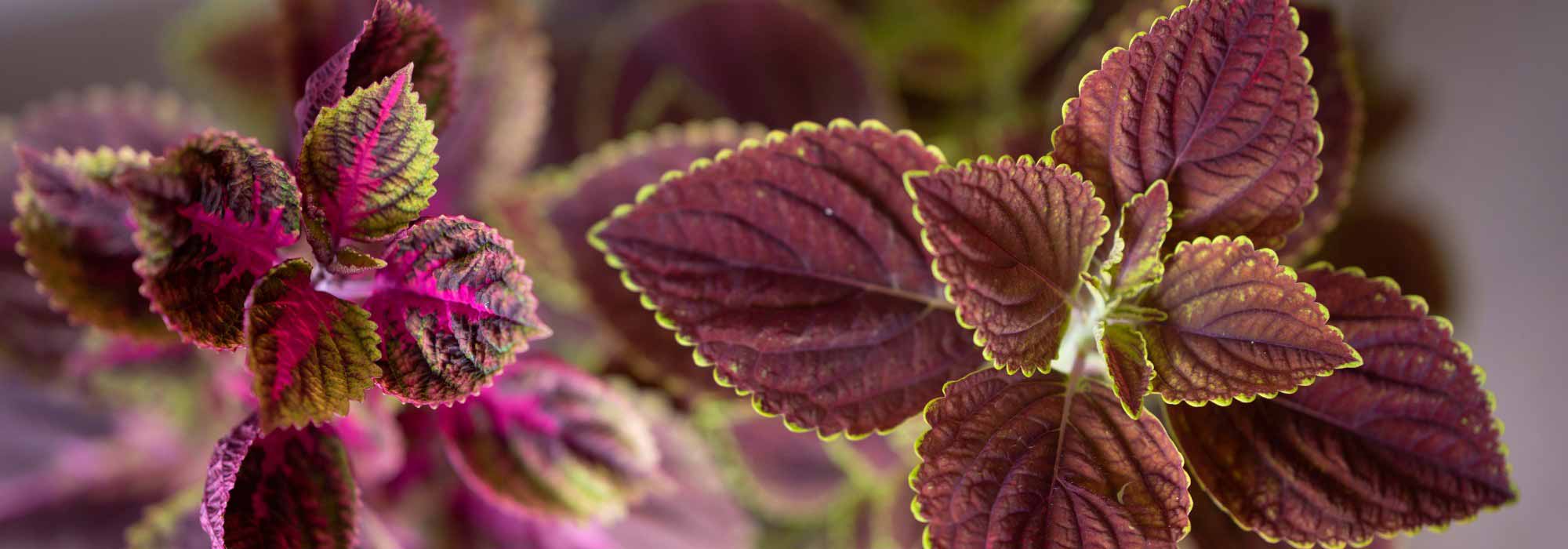
Coleus : growing and caring for it indoors
Contents
Coleus in a Few Words
- It boasts highly colourful and variegated foliage with stunning shades
- It exhibits rapid growth and is easy to cultivate indoors with minimal maintenance
- It thrives in bright light without direct sunlight and prefers moderate watering
- It comes in numerous varieties, offering a wide palette of colours and patterns
- Frost-sensitive, it is grown as an indoor perennial to add an exotic touch to the home
The word from our expert
The Coleus is a non-hardy perennial plant grown as an annual in our gardens or as a houseplant indoors. A tad flamboyant, it charms with its delicately velvety and intensely coloured foliage, showcasing almost every hue of the rainbow. From soft green to deep purple, with touches of yellow, orange, or pink, it offers an endless array of colours, solid, variegated, bicolour, or even multicolour. Among the most popular varieties, the ‘Wizard’ coleus stands out for its contrasting patterns, while the ‘Kong’ coleus impresses with the generous size of its leaves.
Ideal for bright interiors, the coleus thrives under indirect light and in well-drained soil. Its bushy habit and rapid growth make it a perfect plant to green up a corner of a room or a shelf. A simple pinch of the stems helps densify its foliage, while moderate watering ensures it stays beautiful over time. It can be grown alone in a simple pot to showcase its vibrant foliage or paired perfectly with other green plants in more neutral tones for a contrasting effect.
Discover the coleus, this irreplaceable plant for adding a stunning exotic touch to your home, where it will live for several years.
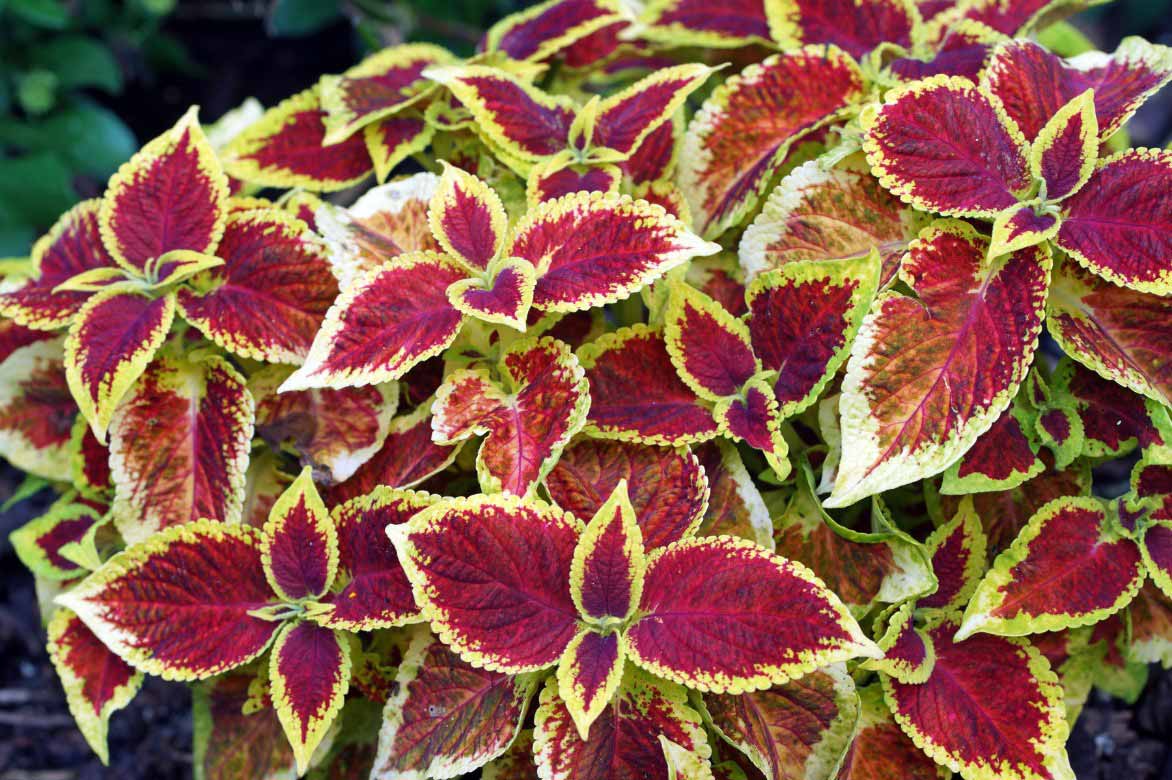
Botany
Botanical data
- Latin name Coleus
- Family Lamiaceae
- Common name Coleus, painted nettle, flame nettle, poor man's croton, gipsy plant
- Flowering July to October
- Height 30 to 50 cm
- Sun exposure Bright
- Soil type Rich, well-drained substrate
- Hardiness Frost-sensitive
Coleus is a herbaceous perennial plant belonging to the Lamiaceae family, much like nettles, sage, and lavender, a large family that includes many aromatic and ornamental plants. Its genus name “Coleus” comes from the Greek “koleos,” meaning “sheath” or “case,” referring to the way its stamens are partially fused.
In French, this plant is commonly called “coléus,” but it is also known by the nicknames “coliole,” “gipsy plant,” “painted nettle,” or “flame nettle”, due to the resemblance of its foliage to that of nettles. In the wild, coleus grows mainly in the tropical undergrowth of Southeast Asia and Africa, where it thrives in dappled light and rich, moist soil.
Although perennial in tropical climates, it is grown as an annual outdoors in temperate climates, as it does not survive frost. Its sensitivity to low temperatures makes it an excellent conservatory plant, where it enjoys bright and temperate conditions year-round. Indoors, it is a highly ornamental plant prized for its vibrant foliage.
Formerly classified in the genus Coleus, coleus now belongs to the genus Solenostemon, which includes over 150 species, as well as numerous cultivars and hybrids. The most common varieties in garden centres are derived from Solenostemon scutellarioides (syn. Coleus blumei). These cultivars, often grouped into series based on their colours, are distinguished by particularly ornamental foliage, ranging from soft green to deep purple, sometimes enhanced with shades of pink, yellow, or orange, in solid, bicolour, or even tricolour patterns, offering an almost limitless choice for both outdoor annual beds and indoor cultivation.
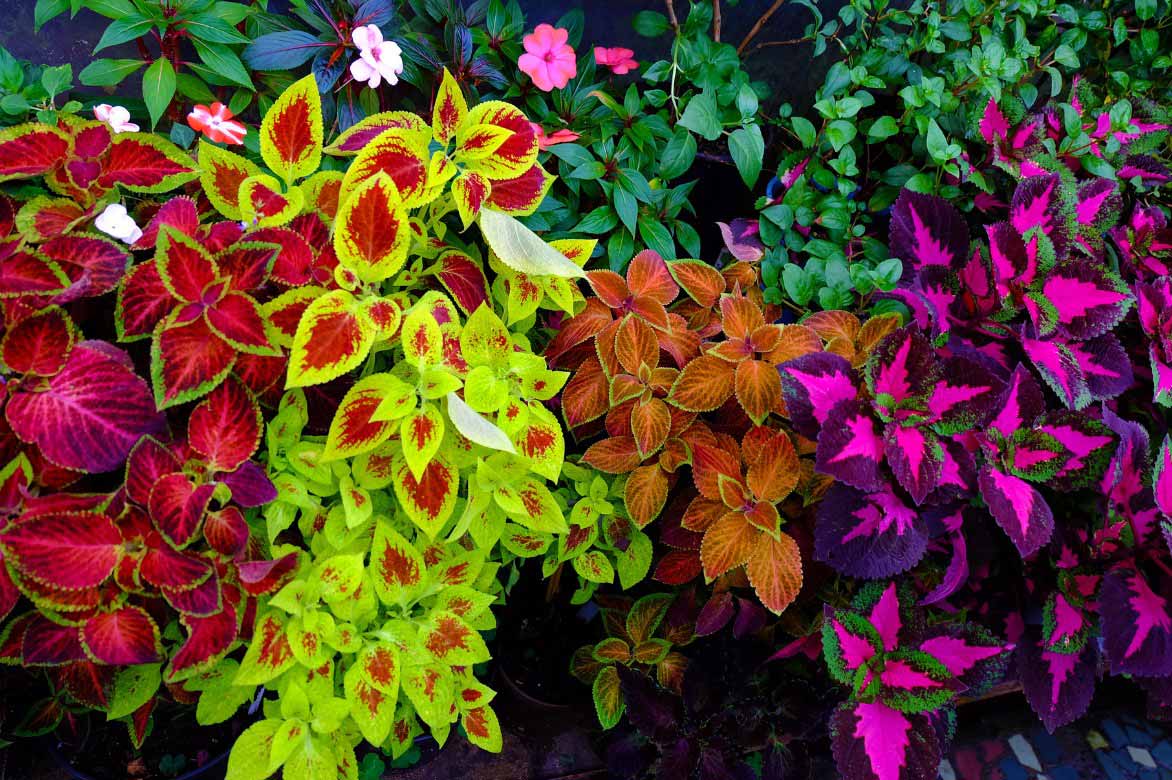
There are many varieties of Coleus, offering vibrant and luminous foliage colours
Fast-growing, coleus forms beautiful bushy clumps, compact, dense, and well-branched. Its habit is upright and slightly pyramidal, with stems that branch naturally. Depending on the variety, it reaches 30 to 50 cm in height and spread in a single season. Although its lifespan indoors may be limited to a few years, it renews easily through propagation by cuttings, allowing it to be kept indefinitely. Its main appeal lies in its foliage, which is far more ornamental than its flowers.
Coleus is distinguished by its oval or triangular leaves, typically measuring between 5 and 15 cm long and 3 to 10 cm wide, though these dimensions can vary by variety. Their finely toothed edges give them a slightly crenate appearance, more or less pronounced depending on the cultivar. Their serrated edges resemble those of nettles or mint, earning it the nickname “painted nettle.” The leaf surface is often velvety, covered with a fine down. The texture may be more or less puckered, with some varieties featuring prominent veins that add a unique relief to the leaf. Their opposite arrangement on square stems is a typical characteristic of the Lamiaceae family. Each pair of leaves grows directly opposite the previous one, creating a regular and balanced pattern. The stems, though flexible and slightly brittle, provide good support for the leaves and contribute to the plant’s bushy appearance. In some varieties, they may also display purple or reddish hues.
The incredible chromatic diversity of the foliage is one of coleus’s main attractions. The palette ranges from absinthe green to acid yellow, from rust to deep purplish-red, almost black, as seen in the coleus ‘Palisandra’. Some varieties develop intense shades of Indian pink, while others display a more discreet cream-white. Depending on the cultivar, the foliage may be solid, bicolour, or tricolour, with varied patterns such as contrasting veins, marbling, or differentiated edges, or with subtle gradients.
The flowering, though discreet, produces small clusters of blue or purple flowers that appear in summer, but they are often removed to focus the plant’s energy on foliage. Fruiting is anecdotal in ornamental cultivation, as coleus is primarily grown for its leaves. However, if the flowers are left in place, they may give way to small black seeds at the end of the cycle. These seeds can be harvested and saved for home sowing, though the resulting plants may show variations in colour and pattern compared to the parent plant, due to the genetic variability of cultivated hybrids.
Beyond its ornamental appeal, coleus has also been used in certain medicinal traditions, particularly in Asia and Africa, where its extracts were employed to treat various inflammatory and digestive disorders. A specific species, Coleus forskohlii (now classified in the genus Plectranthus), is known to contain forskolin, an active compound studied for its effects on metabolism and cardiovascular health. This molecule has attracted researchers’ interest due to its potential role in dilating blood vessels and stimulating certain enzymes involved in cellular regulation.
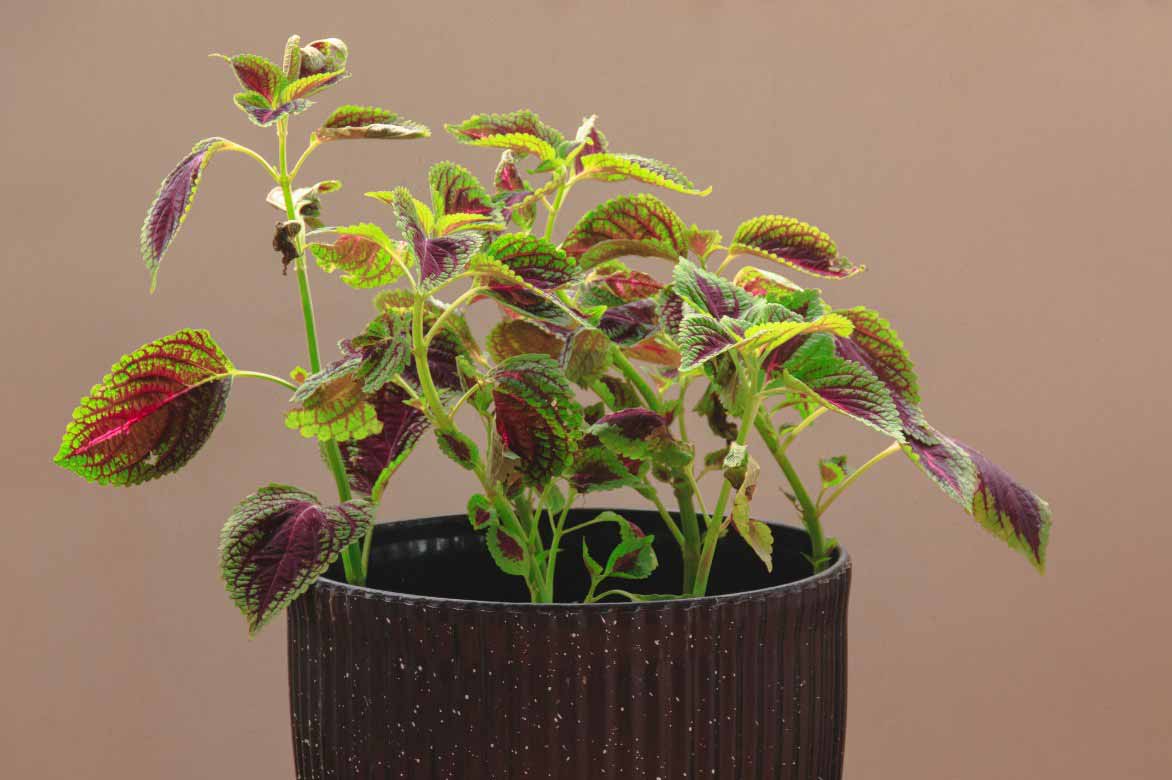
Coleus amboinicus
Main species and varieties
Coleus plants from the Solenostemon scutellarioides species are available in different seed series, such as the Wizard® series, and are also offered as plug plants.
Our Favourite Varieties
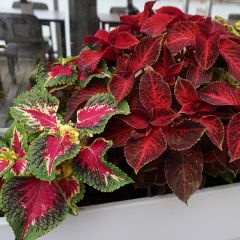
Solenostemon Kong Mix
- Flowering time July to October
- Height at maturity 45 cm
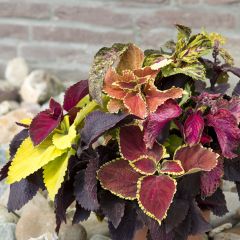
Coleus Pinto Mix seeds
- Flowering time July to November
- Height at maturity 50 cm
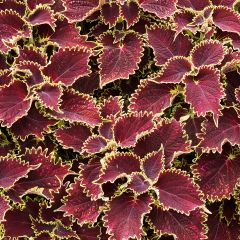
Coleus Vulcan
- Flowering time November
- Height at maturity 60 cm
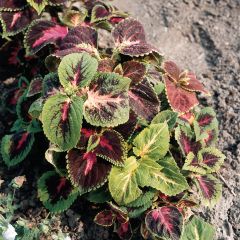
Coleus Rainbow Mix Seeds
- Flowering time July to November
- Height at maturity 50 cm
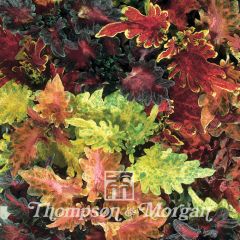
Solenostemon Dragon Sunset & Volcano Mixed
- Flowering time July
- Height at maturity 50 cm
Discover other Coleus seeds
View all →Available in 1 sizes
Available in 1 sizes
Available in 1 sizes
Available in 1 sizes
Available in 1 sizes
Available in 1 sizes
Available in 1 sizes
Available in 1 sizes
How to grow coleus indoors?
Where to place coleus?
Coleus should be placed in a bright environment, but without direct sunlight, which could scorch their delicate foliage. Bright indirect light or a few hours of gentle morning or late afternoon sun are ideal. They thrive in a stable ambient temperature, between 18 and 25 °C, and dislike cold drafts as well as sudden temperature fluctuations. Indoors, they do well on a bright windowsill, a well-lit shelf, or even in a temperate conservatory where they can flourish fully.
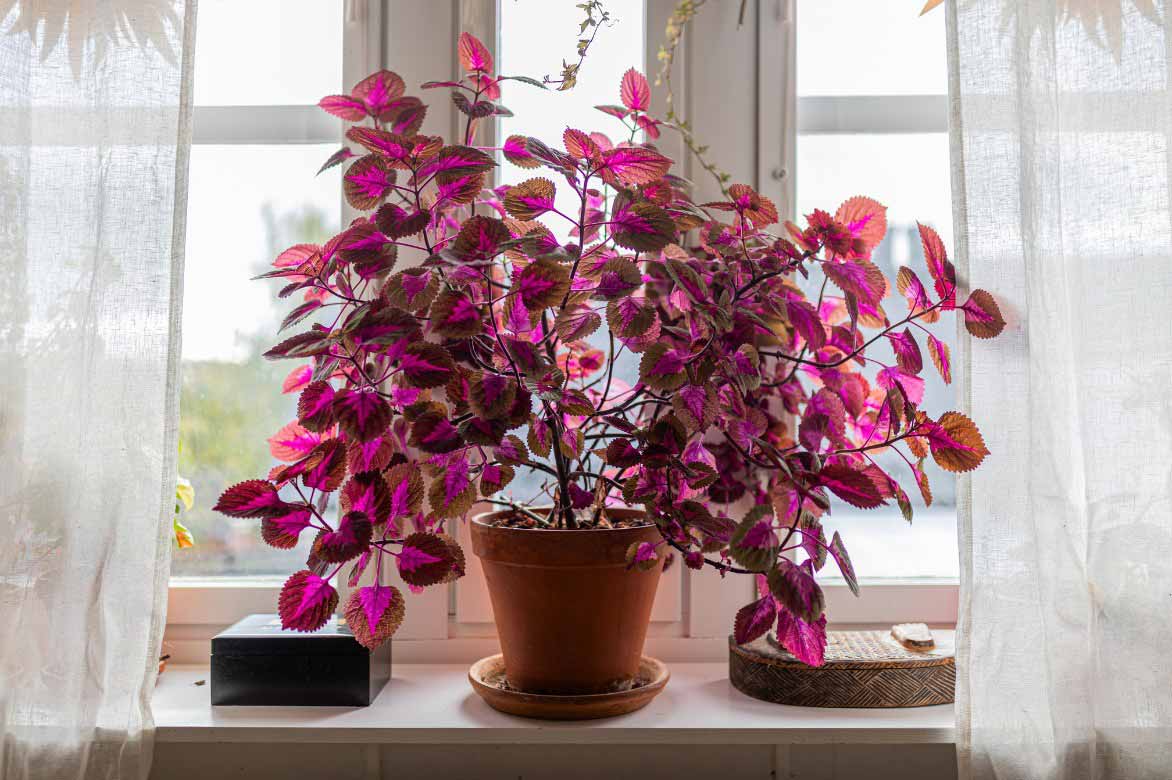
Place the Coleus in a bright spot, ideally near a window
When to plant coleus in a pot?
Coleus can be planted or repotted throughout the year, but it is best to do so in spring or early summer, when the light is more intense and the plant enters its active growth phase.
Which pot to choose?
Coleus has a shallow root system but appreciates a container with enough space to grow. A 15 to 20 cm diameter pot made of terracotta or plastic is usually sufficient. Ensure it has drainage holes, as coleus cannot tolerate excess water.
What substrate to use?
A mix of potting soil and well-decomposed compost provides a rich substrate, promoting growth and foliage colour. Here’s an ideal blend to ensure a good balance between water retention and drainage, avoiding the risk of root rot:
- 50 to 60% universal potting soil or houseplant compost, serving as a nutritious base and retaining the moisture needed for coleus development.
- 20 to 30% perlite, coarse sand, or vermiculite, aerating the substrate and improving drainage, reducing the risk of root suffocation.
- 10 to 20% well-decomposed compost, providing essential nutrients to stimulate growth and strengthen the plant’s resilience.
- A layer of clay pebbles or gravel placed at the bottom of the pot to facilitate water drainage and prevent stagnation that could lead to root diseases.
How to plant coleus in a pot?
For optimal growth, it is advisable to plant only one plant per 15 cm diameter pot. If coleus is grown alongside other plants in a planter, ensure a spacing of 15 to 20 cm between each plant to avoid competition and promote good air circulation.
- Spread a layer of gravel or clay pebbles at the bottom of the pot to ensure good drainage and prevent water stagnation.
- Fill with the substrate.
- Place the coleus in the pot, ensuring the base of the stem is level with the substrate.
- Top up with substrate and lightly firm around the roots.
- Water moderately: an initial watering helps thoroughly moisten the substrate and encourages root establishment.
- Place the pot in a bright spot, but avoid overly intense direct sunlight.
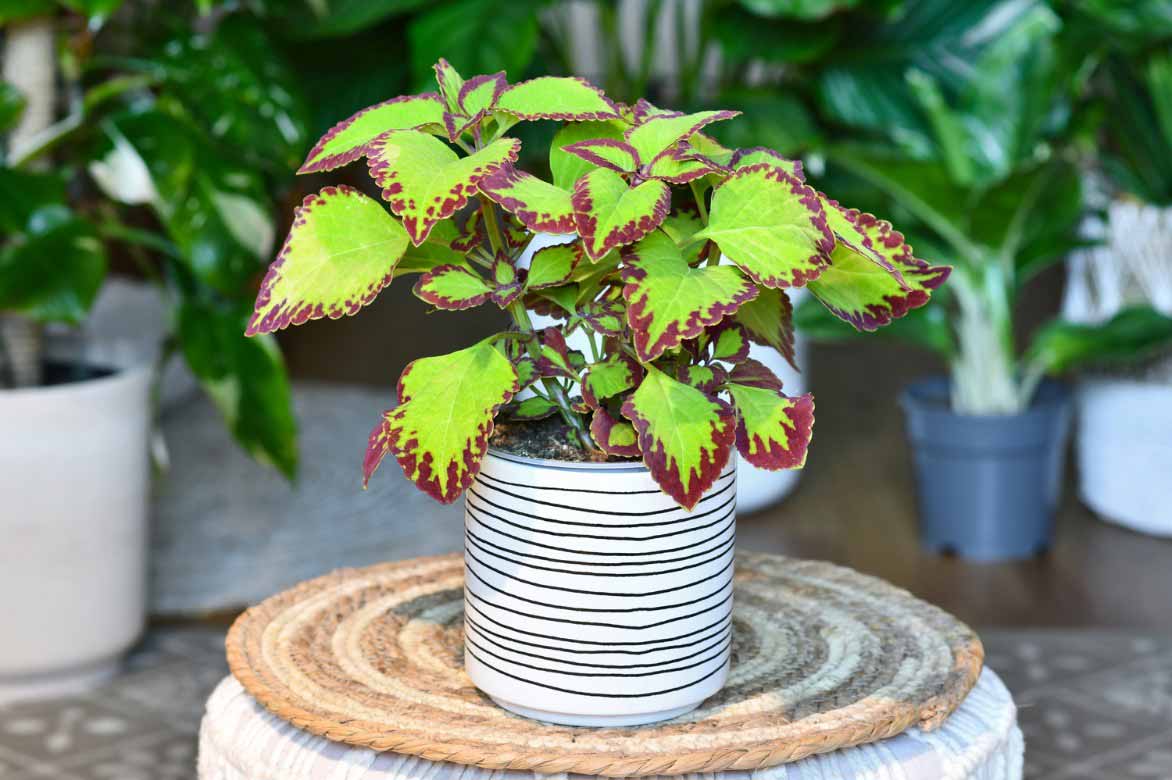
Coleus blumei ‘Velvet’
How to sow coleus seeds?
Our coleus are available as plug plants, but we also offer a lovely collection of coleus seeds to sow in late winter or spring. Here are our tips for successful coleus seed sowing:
- Fill a pot with well-draining potting soil.
- Scatter the seeds on the surface of the soil without covering them, as they need light to germinate.
- Moisten the substrate lightly.
- Maintain a temperature of 20 to 22 °C and ensure the substrate stays moist until germination, which occurs in 10 to 15 days.
- Once the seedlings appear, thin them out to give each plant space and encourage their growth.
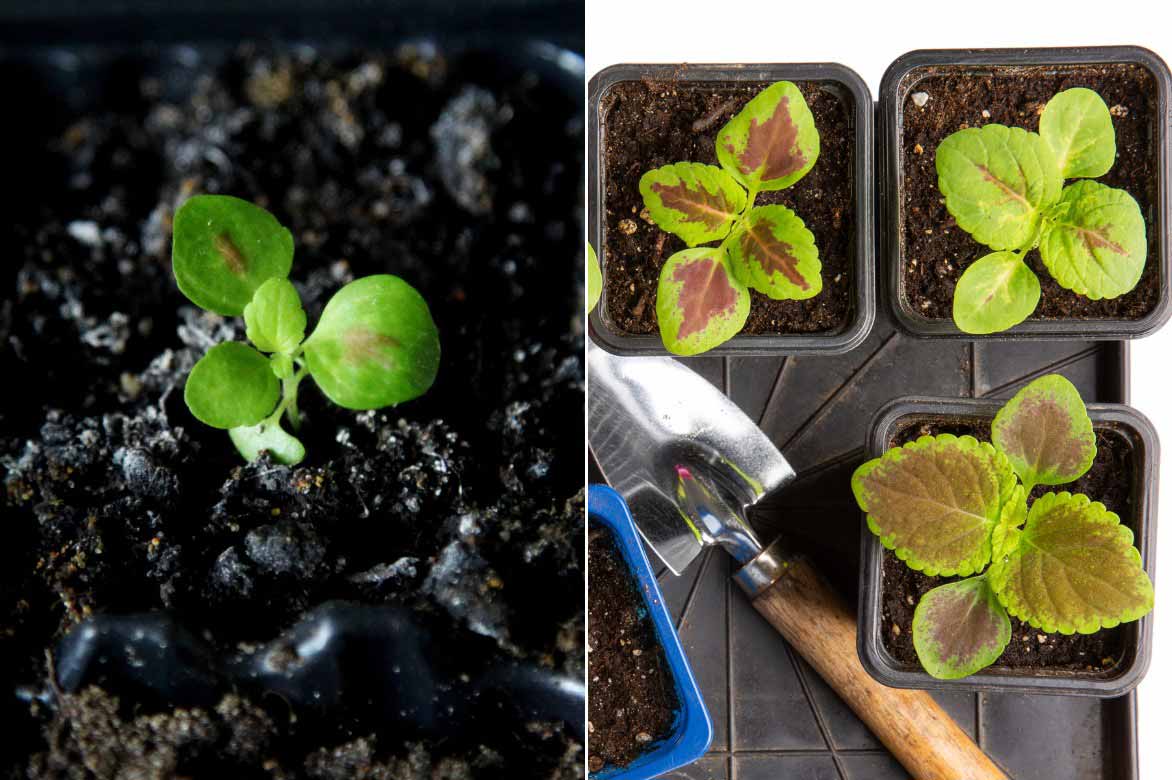
On the left, a small coleus seedling from sowing (the foliage colour is already visible!), and on the right, coleus repotted into individual pots.
How to care for potted coleus?
The coleus is an easy-to-grow indoor plant.
Watering: How and How Often?
The coleus prefers a slightly moist substrate, without excess water.
- In spring and summer: water 2 to 3 times a week when the surface of the substrate begins to dry. It is important not to let water stagnate in the saucer.
- In autumn and winter: reduce watering to once a week, allowing the compost to dry out a few centimetres between waterings.
Preferably use water at room temperature, ideally non-calcareous (rainwater or filtered water). In winter, when the indoor air becomes dry, lightly mist the foliage or place a tray of water with clay pebbles nearby to maintain sufficient humidity.
Fertilisation: Which Fertiliser and How Often?
To encourage vigorous growth and vibrant colours, the coleus requires a regular supply of nutrients. During spring and summer, you can apply a liquid fertiliser for green plants or geraniums every two weeks to support its development. In autumn and winter, it is best to reduce applications to once a month or even suspend them if growth slows.
Pruning: Should You Pinch or Prune the Coleus?
Regular pruning stimulates branching and results in a more compact habit.
- Pinching young shoots: once the plant reaches 10 to 15 cm in height, pinch (i.e., cut with your fingers) the tips of the stems to encourage the production of new branches.
- Removing flowers: the flowers of the coleus are insignificant, and their development drains the plant. It is recommended to remove them as soon as they appear to focus energy on the foliage.
- Removing damaged leaves: regularly remove yellowed or dried leaves to maintain an aesthetic appearance and prevent diseases.
Repotting
A pot-grown coleus needs repotting every 1 to 2 years, usually in spring, when the roots begin to fill the pot. On this occasion, you can opt for a slightly larger container (2 to 3 cm in additional diameter) and renew the substrate to provide fresh nutrients.
→ To learn more, read our advice sheet: “Indoor Coleus: Care Through the Seasons“.
What are the common problems with coleus indoors?
Although relatively hardy, coleus can be susceptible to certain pests and diseases, especially when grown indoors under inadequate conditions (excessive moisture, overly dry air, poor ventilation).
Common Parasites
- Aphids: often found on young shoots, they weaken the plant by sucking the sap and can cause leaf curling. Solution: spray with black soap on affected areas (15 to 30 g of black soap diluted in one litre of water).
- Spider mites: they appear in dry conditions and cause yellowing of the foliage, with fine webs under the leaves. Solution: increase ambient humidity by regularly misting the plant and placing a tray of water with clay pebbles nearby.
- Whiteflies (aleurodes): these small flying insects lay eggs under the leaves, causing general weakening of the plant. Solution: install yellow sticky traps and treat with black soap.
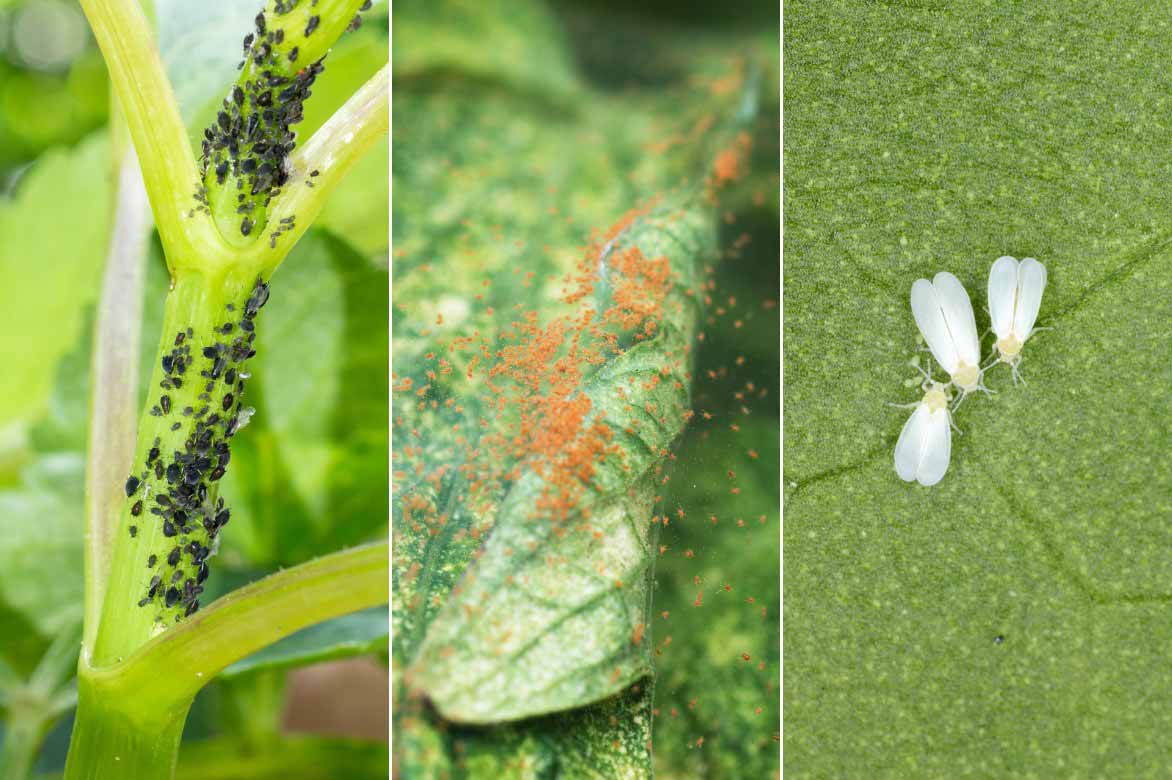
Aphids, spider mites, and whiteflies
Frequent Diseases
- Root rot: caused by overwatering and poor drainage, it manifests as sudden wilting of the plant and blackening of the stem base. Solution: space out watering, use well-draining soil, and ensure the pot has drainage holes.
- Powdery mildew: this fungus forms a white powdery deposit on the leaves, favoured by excessive humidity and poor air circulation. Solution: remove affected leaves, improve ventilation, and treat with sulphur or a horsetail decoction.
- Botrytis (grey mould): it often attacks plants in overly humid and cold conditions, causing rotting of leaves and stems. Solution: space out plants to improve air circulation and avoid wetting the foliage when watering.
How to Prevent These Issues?
- Avoid overwatering, water moderately, and ensure good pot drainage.
- Mist the foliage regularly to prevent spider mites.
- Avoid confined spaces and space out plants to limit mould risks.
- Inspect the undersides of leaves to detect pests early.
- Remove diseased or yellowed leaves to limit disease spread.
- Use natural treatments: black soap against aphids, nettle manure to strengthen the plant, horsetail decoction to prevent fungi.
Learn more in our article: Coleus Indoors: Preventing and Treating Diseases and Parasites.
How to propagate coleus?
Coleus propagates easily, mainly by cuttings, but also by sowing. Propagation by cuttings is the quickest and most reliable method to faithfully reproduce a variety, while sowing allows for new variations in colour and shape.
Propagation by Cuttings
Propagation by cuttings is the most common technique for multiplying coleus, as it guarantees a plant identical to the parent. It can be done year-round indoors, but preferably in spring or summer, during active growth periods.
How to take coleus cuttings?
- Take a healthy stem 8 to 12 cm long, just below a node.
- Remove the lower leaves, leaving only 2 to 3 pairs of leaves at the top of the stem.
- Place the stem either in a glass of water for quick rooting (roots appear in 7 to 10 days) or directly in soil in a light, moist substrate.
- Keep at a temperature of 20 to 25 °C, in light but without direct sunlight.
- Transplant into a permanent pot once the roots are well developed (about 2 to 3 weeks after taking the cutting).
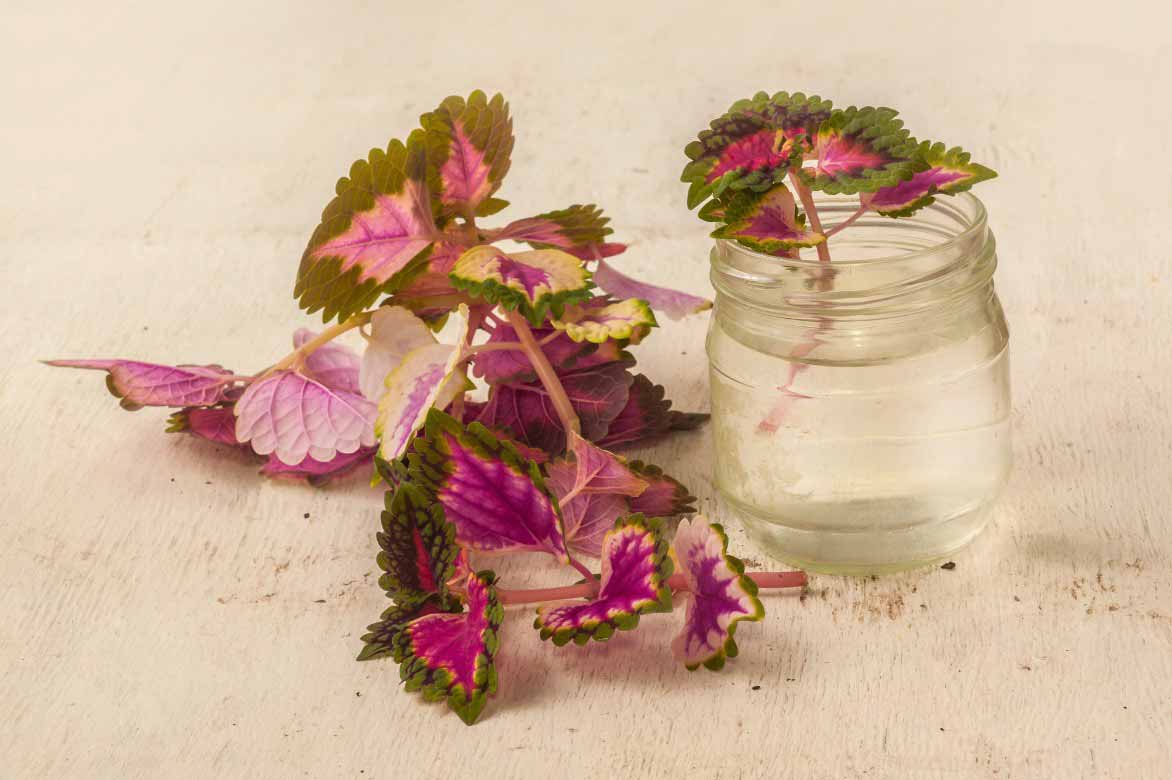
Coleus propagates easily in water
Sowing
Propagation by sowing (as described above) allows for coleus with varied colours, but the characteristics of the young plants obtained may differ from the parent plant.
Our decorating ideas for incorporating a coleus indoors
Which Pot to Choose?
With its striking and contrasting foliage, the coleus is a plant that stands out aesthetically on its own. To avoid an overly busy visual effect, it’s best to opt for a simple pot that will highlight its colours without creating decorative overload. A highly graphic and colourful foliage pairs better with pots in neutral and natural tones. White and light grey add a contemporary and elegant touch, while terracotta or matte black offer a subtle contrast.
Use Colour Sparingly
If you feel drawn to a colourful pot, it’s better to choose a shade that complements one of the foliage hues rather than introducing an additional colour. The idea is to maintain chromatic harmony. A burgundy or plum pot will enhance a coleus with purple tones, while a mustard yellow or olive green will highlight more golden nuances.
To avoid an overly cluttered visual effect, consider integrating your coleus into a balanced setting:
- Solo: Placed on a shelf, coffee table, or windowsill, it immediately catches the eye with its vibrant foliage.
- In a composition: The coleus pairs perfectly with plants featuring solid green foliage, which softens its flamboyant appearance. For example, you can combine it with ferns, pothos, calatheas, or monsteras.
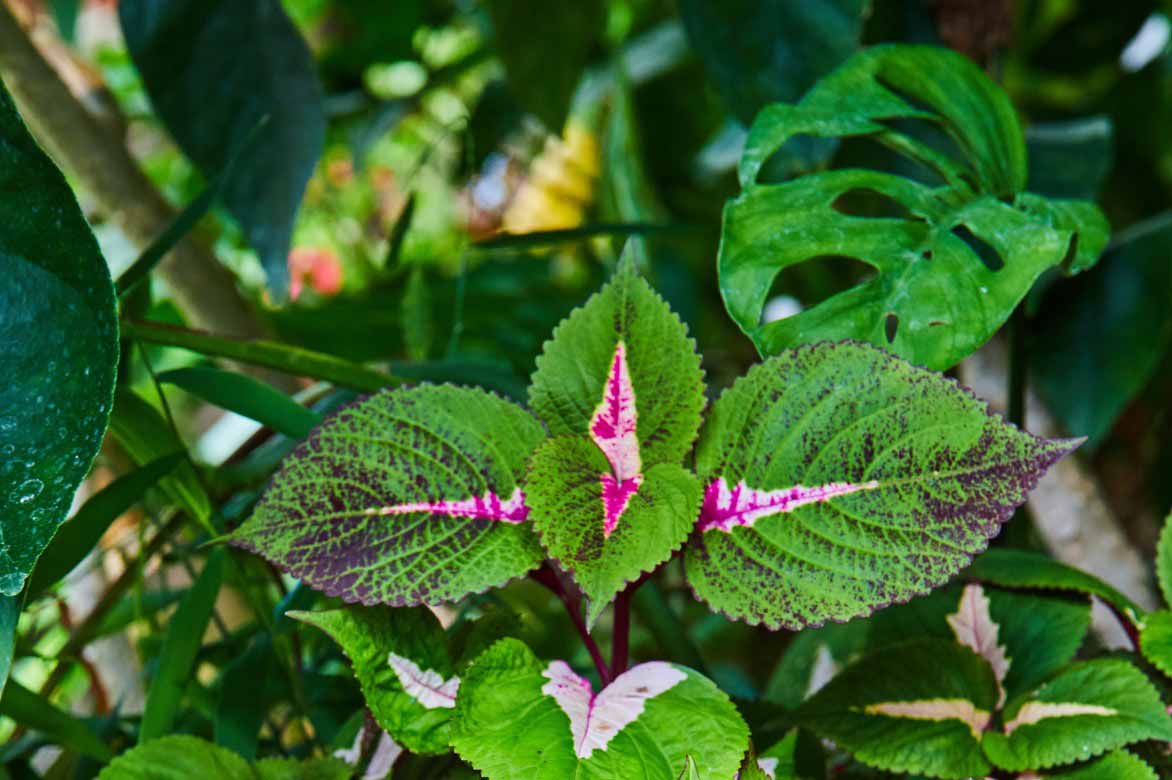
The coleus benefits from being paired with lush-foliage plants (here, with a Monstera) for a jungle effect!
Also worth reading
- Discover our full range of coleus seeds
- Explore our comprehensive guide: “Coleus: sowing, planting, and care”
- Subscribe!
- Contents
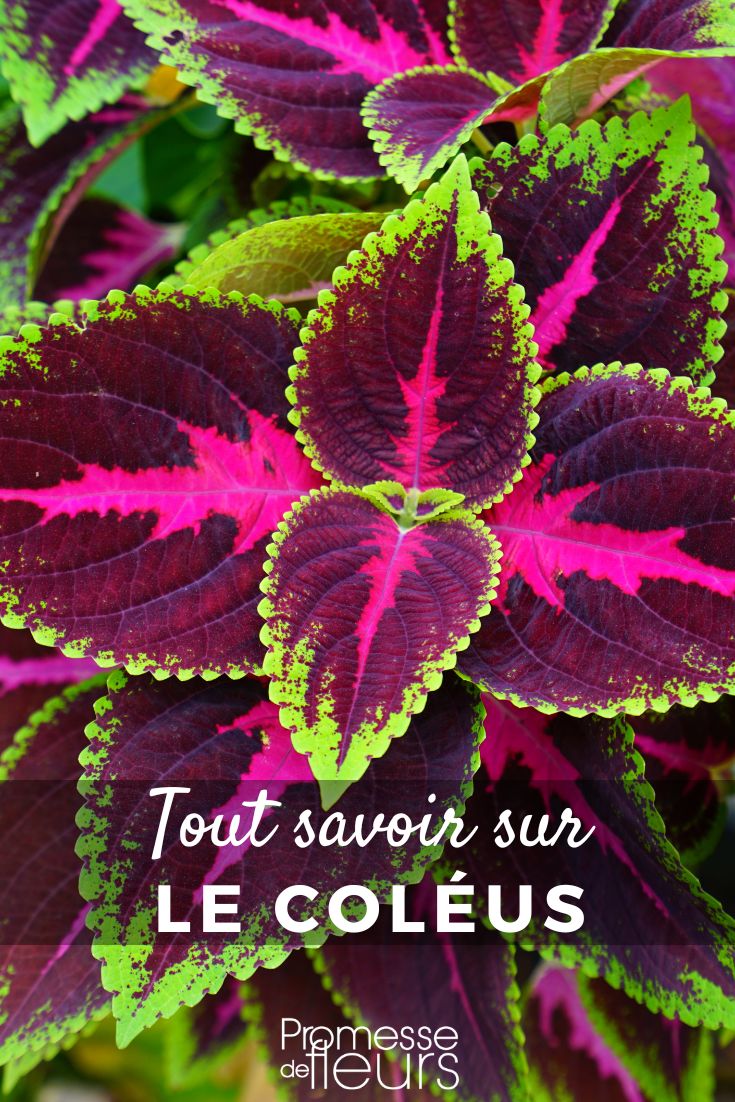



































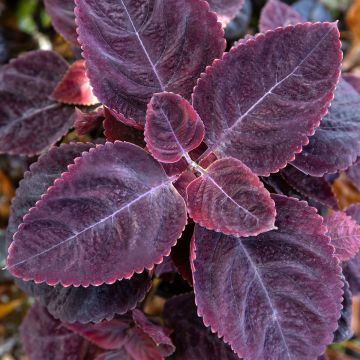
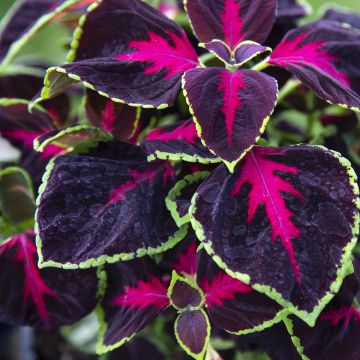
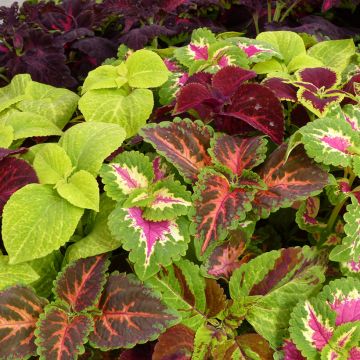
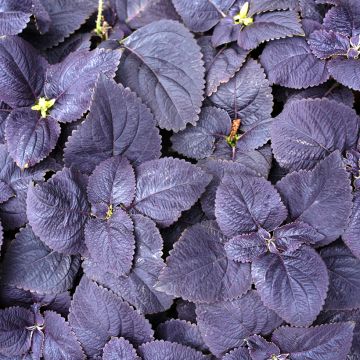
Comments